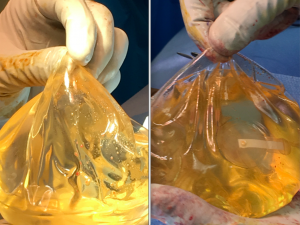Removal Of Ruptured Becker Breast Implants
Posted On: January 18, 2019 Author: The Office of Dr. Stuart Linder Posted In: Breast topics, Ruptured Implant, Uncategorized
Recently, I had the opportunity to surprisingly operate on a patient who had a Becker double lumen ruptured implant. This patient is a 52-year-old middle eastern female status post augmentation mammoplasty silicone gel implants per, with no identifiable records or patient’s accountability as to the type or size of her implants.
Intraoperatively, it was identified to be double lumen bilateral ruptured silicone and outer lumen saline ruptured implants. Please see the photographs showing the ruptured Becker implant. These are very unusual implants that were placed three decades ago. There are very few of them still remaining in women throughout the world and it was a surprise finding in the operating room. This patient desired to have the implants removed completely with explantation without reimplantation and drainage tube placement. She also underwent breast mastopexy lift in order to reconstruct the shape of her breasts after losing a significant portion of her volume.
Becker implants were double lumen implants placed many years ago. They had silicone inner lumen with an external secondary compartment of salt water. The majority of these implants have been removed over the last 15 to 20 years and the few residual that are found require bilateral double lumen implant removal with removal of capsules often with calcification from leakage silicone.
CASE STUDY

This patient is a 57-year-old white female who presents with a 29-year-old silicone double lumen Becker/saline implants placed almost three decades ago. She now presents with severe encapsulation, ruptured outer lumen saline with scar tissue contracture. Note on her preop frontal view that she has superior retropositioning of the implant and a double bubble breast deformity. She is in excruciating pain and the implants positioning has risen over the last two years. MRI is showing both rupture and intra and extracapsular silicone extravasation, although there is no specific linguine sign and therefore no specific rupture of the shell, the outer lumen saline implant has been broken and the saline has resorbed.
In order to reconstruct this patient, multiple steps in the operating room were performed, including open capsulectomy, removal of silicone implant and calcified granulomas, inferior release and removal of the parasternal as well as the lateral inframammary across major muscle attachments. This is the way in which the implant can maintain itself at a lower position and not rise. Also implants will be constructed. Patient had 140 and 239 cc silicone implants placed by gram weight on a scale in the operating room as the implant bags had no specific volumes inscribed on them as they do these days. As a result, a 400 cc style 20 silicone gel placed on the right with 300 on the left open capsulectomies were performed, releasing and resection of the parasternal and the lateral muscle attachments were performed. At this the patient was sat up, skin excess was marked out and a formal Wise-pattern breast lift was performed on the right with a vertical lift on the left.
